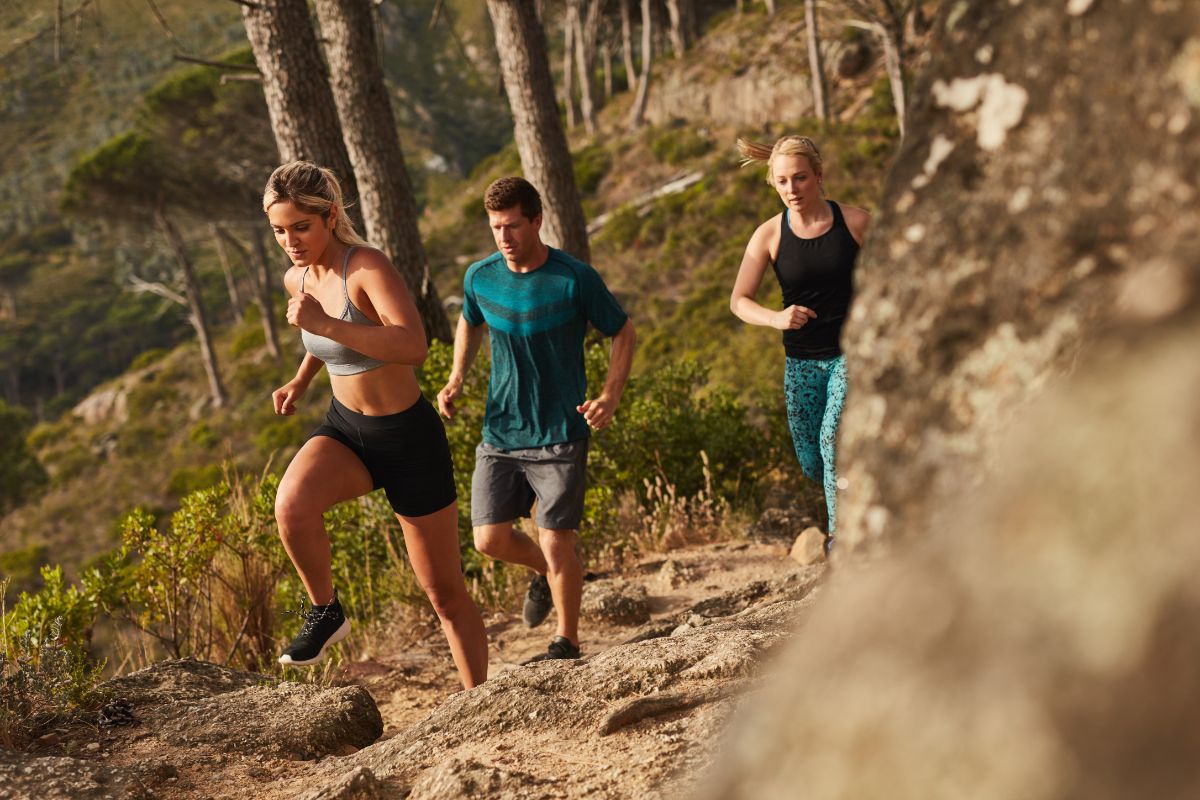What Is Cross Country Running? How To Get Started In XC Running

Cross-country running means running on VARIOUS terrains, such as grassy fields, gravel paths, and even rugged hillsides. It can take you from an open landscape to a forest and over hills to flat terrain.
Compared to running on the street, cross-country running requires more endurance. There is also more variability in heart rate.
Cross country is a popular school activity; many of us remember that from our school days. Still, by the time we’re adults, it’s just a distant memory.
If you’re considering getting involved in cross country running, this article will tell you everything you need to know. Simply keep reading to find out more below.
So What Is Cross Country Running?
In cross country running, you run across a variety of terrains:
- This involves running over gravel, stone paths, grassland, and muddy surfaces.
- It will have you running up steep INCLINES and slippery descents, whilst you’re completely at the mercy of the course.
Cross-country running offers more nature, adventure, variation, and hopefully a little more joy than running on the street. There is always a new route to try.
Cross-country running is more of an experience than a performance. Moving in the terrain also calms the mind.
Since every run is different, comparing mile times makes no sense.
Running cross country (sometimes abbreviated XC) isn’t nearly as popular as track running since the track is more widely known through the Olympics.
But still, XC is a popular sport, performed in many different countries and in many local competitions.
Cross-Country Race Distances
In cross-country running, race distances vary a lot. Local races are typically shorter and international competitions longer.
- In college, XC races are typically around 8K (5 miles) for males and 5K (3.1 miles) for females.
- Most high school cross-country races are 5K (3.1 miles).
- In middle school, most XC runs are around 2-3 kilometers (1.2-1.8 miles).
- In The World Athletics Cross Country Championships, the distance is typically 12K for men and 8K for women, which is run in a 2K loop.
A race begins with a mass start, and runners have a few hundred meters to merge from the broad starting line to the narrower path.
Some courses may be flat, while others have hills, patches of mud, or obstacles like small creeks.
World records are not maintained due to the varying difficulty of courses. In the world championships, male winners typically finish in 30 to 36 minutes, and female winners in 25 to 30 minutes.
The History Of Cross Country
Cross-country running began in England during the 19th century. At first, it was popular in schools (English schools started competing in cross country in 1837).
It gradually became popular, and eventually, in 1867, national championships started.
Early Summer Olympics included cross country races.
Since 1973, the IAAF has hosted the World Cross Country Championships.
When Is Cross Country Season?
XC season runs from September to March. During this period, runners compete in races throughout the United States.
Some schools hold events during the fall, winter, and spring seasons, while others only run in drier months.
Many high school athletes participate in cross country during their junior year. However, many colleges and universities require students to take part in cross country during their freshman year.

How Do I Get Started in Cross Country?
How to Start?
Volunteer at a local XC event. Events are put on because of volunteers, which would not be possible without them. And local running clubs are run by volunteers, so ask the club if you can help.
Get involved in the community. The communities in XC are smaller, making them more supportive and easier to join. Even though races are competitive, people still want to help each other.
You’ll be running through various terrain and hills when you participate in an XC event.
Replicate that by adding steep hills and different terrains on your runs.
But build up your training gradually instead of just diving straight in. The key is stamina.
You need to have variety. So have different types of running workouts in your schedule: long runs, tempo runs, interval sessions, and recovery runs.
Run different climbs, and try to reach the fastest pace possible. Build this up gradually over a number of weeks.
Sprinting on grass is also a great way to prepare, as it will help you work on your running economy. Grass causes our knees to lift higher, increasing our cadence.
What Should You Wear In Cross Country Training?
Another important thing that you should factor into your XC training is the clothing that you’re wearing.
You can wear the usual running shorts and a running shirt, but the type of shoes is important.
You can use two types of shoes, one of which is specially designed for XC:
- XC shoes have spikes that allow better grip on slippery surfaces such as muddy grass and hills. XC shoes have a tighter fit that helps in tight turns and uneven ground. They have very little cushioning and are pretty thin to save weight.
- Trail running shoes have a softer sole to provide a better grip on slippery trails and different terrains. Trail running shoes have less cushioning than traditional running shoes because the terrain is softer than on the road.
Example of cross country shoes – Saucony Kilkenny XC 9 (men's).

Example of trail running shoes – Salomon XA PRO 3D V8 (men's).

What Is the Difference Between Cross Country Running and Trail Running?
Two things are common: cross country and trail running are outdoor sports. And they are less popular than road running.
But cross country and trail running differ in many ways:
- The distances in cross country races are more regulated. Trail running races can vary in distance and terrain.
- Most cross country races take place on short courses, where competitors take multiple laps. Trail runners cover much longer distances.
- XC events are often held near a town and in a field. A trail event usually takes place on isolated trails far from the beaten path (like on hiking trails).
- Cross country will typically have only a few short hills to tackle. Long, steep ascents and descents are part of trail running.
- XC runners wear minimal gear. They might wear spikes in their shoes because of the slippery grass. Trail runners have shoes with deeper rubber lugs and carry a backpack with water, spare clothes, etc.
There is one more thing that is common. Entry fees for cross country and trail races are typically very cheap compared to the typical 5K/10K street runs.
And in cross country, you don’t usually get anything extra (no drink stations, no medals, no shirts). You just show up and run.
Final Thoughts
Although it can be difficult to begin training at first, as you’ll be using a lot of muscles that haven’t been practiced, you will gradually build up your mental and physical tenacity.
Beginners can benefit from cross-country running. The ground is softer, so it doesn’t stress the legs as much as jogging on the road. On the other hand, it can be extremely hard depending on the terrain.
But it’s incredibly fun dashing over a series of different terrains and obstacles.






